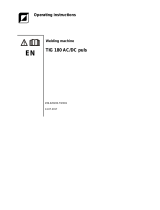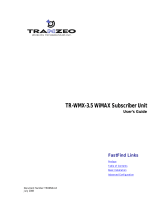EWM STICK 450 Operating Instructions Manual
- Category
- Welding System
- Type
- Operating Instructions Manual
This manual is also suitable for
EWM STICK 450 - The EWM STICK 450 inverter welding machine is a portable device designed for STICK welding. It is suitable for use in environments with an increased electrical hazard, as it complies with VDE 0544 (EN 60974-1). With a welding current range of 350A to 450A, it is capable of handling a variety of welding tasks. The STICK 450 features a user-friendly logic control system that provides precise control over the welding parameters, ensuring optimal weld quality. It also supports remote controls for added convenience.
EWM STICK 450 - The EWM STICK 450 inverter welding machine is a portable device designed for STICK welding. It is suitable for use in environments with an increased electrical hazard, as it complies with VDE 0544 (EN 60974-1). With a welding current range of 350A to 450A, it is capable of handling a variety of welding tasks. The STICK 450 features a user-friendly logic control system that provides precise control over the welding parameters, ensuring optimal weld quality. It also supports remote controls for added convenience.




















-
 1
1
-
 2
2
-
 3
3
-
 4
4
-
 5
5
-
 6
6
-
 7
7
-
 8
8
-
 9
9
-
 10
10
-
 11
11
-
 12
12
-
 13
13
-
 14
14
-
 15
15
-
 16
16
-
 17
17
-
 18
18
-
 19
19
-
 20
20
-
 21
21
-
 22
22
-
 23
23
-
 24
24
-
 25
25
-
 26
26
EWM STICK 450 Operating Instructions Manual
- Category
- Welding System
- Type
- Operating Instructions Manual
- This manual is also suitable for
EWM STICK 450 - The EWM STICK 450 inverter welding machine is a portable device designed for STICK welding. It is suitable for use in environments with an increased electrical hazard, as it complies with VDE 0544 (EN 60974-1). With a welding current range of 350A to 450A, it is capable of handling a variety of welding tasks. The STICK 450 features a user-friendly logic control system that provides precise control over the welding parameters, ensuring optimal weld quality. It also supports remote controls for added convenience.
Ask a question and I''ll find the answer in the document
Finding information in a document is now easier with AI
Related papers
-
EWM inverter STICK 350 CEL KLR Operating Instructions Manual
-
EWM inverter TIG 250 DC Operating Instructions Manual
-
EWM PICO 260 CEL PWS Operating Instructions Manual
-
EWM TETRIX 300 AC/DC COMFORT activArc Operating Instructions Manual
-
EWM Stick 350 cel Operating Instructions Manual
-
EWM TETRIX 421 AC/DC COMFORT activArc Operating Instructions Manual
-
EWM PICOTIG 180 AC/DC Operating Instructions Manual
-
EWM TRITON 400 DC Operating Instructions Manual
-
EWM PHOENIX 351 EXPERT forceArc Operating Instructions Manual
-
EWM TETRIX 300 AC/DC COMFORT activArc Operating Instructions Manual
Other documents
-
Barco FR12 series Owner's manual
-
Barco FR12 series Owner's manual
-
ESAB DTA 400 AC/DC User manual
-
 TEAMWELDER TIG 180 AC/DC puls Operating Instructions Manual
TEAMWELDER TIG 180 AC/DC puls Operating Instructions Manual
-
Electro-Voice PWS Owner's manual
-
Ashly KLR 4000 User manual
-
Ashly KLR 2000 User manual
-
 Tranzeo TR-WMX-3.5 User manual
Tranzeo TR-WMX-3.5 User manual
-
ERICO INTERCEPTOR SI25i Installation guide
-
Boekel Scientific 28L Large Wax Dispenser User manual



























